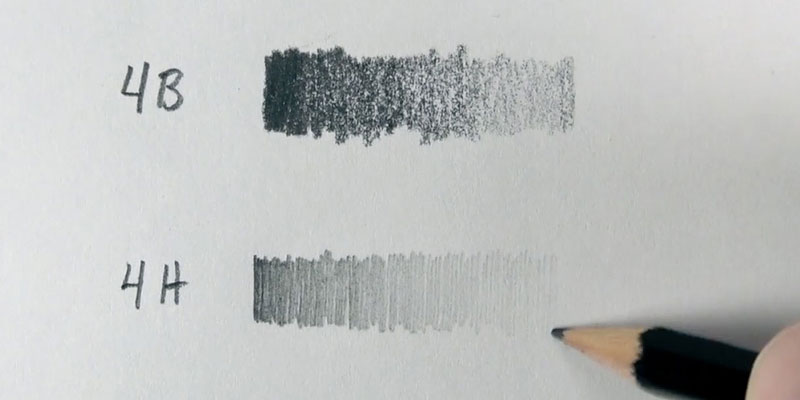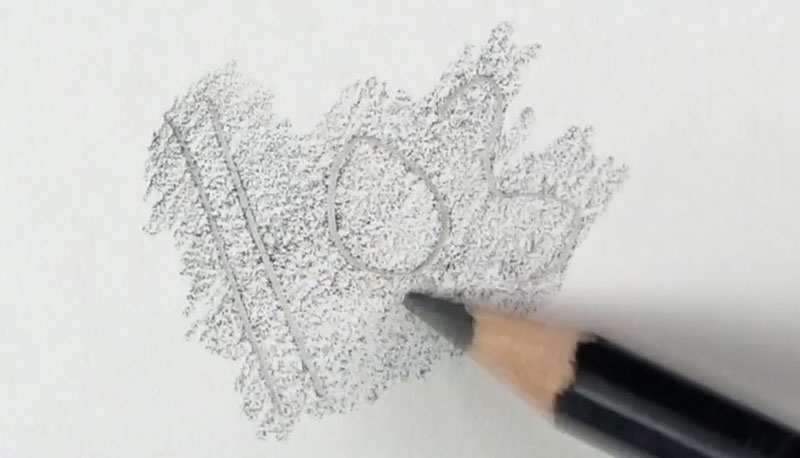
Graphite is the dark gray material usually found encased within a wooden pencil. It comes in many different forms, but most commonly we find it within a pencil. We've all used them to write and draw and most of us feel very comfortable with a graphite pencil in hand.
Although most of us have heard someone refer to the material within a graphite pencil as "lead", you may be surprised to learn that there isn't any lead there at all. Instead, graphite is a form of carbon and is completely safe for drawing.
In this lesson, we'll take a look at the different grades of graphite, why they are designated as they are, and which pencils you may need (and the ones you don't) to find success with graphite drawing.
Graphite is produced in various grades or degrees according to the softness or hardness of the material. Different grades produce different types of marks. The grade of the pencil is usually designated on the side or the end of the pencil. For drawing pencils, this designation is an alphanumeric value.

Writing pencils differ in how they are categorized and usually only feature a number. For example, a #2 pencil is a standard writing pencil - which happens to be of the same softness as an "HB" drawing pencil.
Grades of drawing pencils are organized in a scale based on softness or hardness. An "HB" pencil is found directly in the center of the scale.

"H" pencils feature harder graphite. (The "H" stands for "hard".) "B" pencils feature softer graphite. (The "B" stands for "black".)
The number found in front of the letter reveals just how soft or hard the pencil is. In other words, a "4H" pencil is harder than a "2H" pencil while a "4B" pencil is softer than a "2B" pencil.
Harder pencils produce lighter marks since less of the material is released as pressure is applied. Softer pencils make darker marks since more of the material is released. Therefore, a "4H" pencil will produce lighter marks than an "2H" pencil while a "4B" pencil will make darker marks than a "2B" pencil.
The "F" pencil is similar in mark to an "HB" pencil, only slightly lighter. Like an "HB" pencil, it is capable of producing darker and lighter marks, but without any extremes. The graphite material found in an "F" pencil is slightly harder than an "HB" pencil meaning that it can stay sharp for a longer period of use. For this reason, this pencil is designated as "fine" which is why this pencil is labeled with an "F".
A clear advantage of the "H" pencils is that they can stay sharp for a longer period of use. In contrast, "B" pencils tend to dull quickly due to their softness.
"H" pencils are better suited for filling the tooth or texture of the paper, resulting in smoother transitions of tone and value. "B" pencils fill the tooth to a lesser degree, making the texture of the paper more noticeable. By combining "H" and "B" pencils in a drawing, smooth transitions of tone can be developed without compromising a full range of value.

"H" pencils are clearly capable of producing light marks, but are limited in the range of tone. Putting more pressure on a "4H" pencil will not result in a very dark mark. "B" pencils, however allow for a much broader range of possibilities. A "4B" pencil for example can produce lighter marks by reducing pressure, but is also capable of producing darker marks with additional pressure.
You may be tempted to use a hard pencil such as a "4H" for a preliminary sketch since the mark is light. If your pressure is light, then this is an acceptable practice. But if too much pressure is applied to the pencil, then grooves can be created in the surface of the paper. These grooves become difficult to fill in or cover with softer graphite applications. This can lead to noticeable inconsistencies in the drawing.

Another factor to consider is "graphite shine". Graphite is naturally shiny. However, this shine can be reduced if the graphite is applied using a layered approach. Lighter pencils may be used earlier in the process followed by darker pencils. Even and consistent pressure should be applied with each layer so that the tooth of the paper is not destroyed. (Flattening the tooth often increases the shine.)
"B" pencils tend to produce more shine compared to "H" pencils so it's recommended to gradually increase the contrast in a drawing using a layered approach.
The pencils that are best for you to use will vary depending on several factors. These factors include:
Some folks place a heavy amount of pressure on the pencil naturally. For these artists, a "4B" pencil may be the darkest pencil that is required. For those that naturally produce lighter marks, a much darker "6B" or "8B" may be required.
The surface of the paper also plays a role in the pencils that you choose. Papers with a lighter tooth (smoother surface) may be more receptive to harder pencils and show less of the texture when softer pencils are applied. Papers with heavier textures may be more receptive to softer pencils but reveal more of the surface texture as they are applied.
For quick sketchy drawings, usually only one drawing pencil is required to produce an adequate range of value. If this approach is taken, then a softer "2B" pencil may be all that is needed. For more refined drawings that require a layered approach, several hard and soft pencils may be required.
No matter what the circumstance, every single graphite grade is not required. Most artists will only need a few pencils to be successful. Because softer pencils have a bit more range, most of the pencils that an artist will use fall on the "B" side of the scale. I suggest the following grades - "2H, H, HB, 2B, 4B, and 6B".

Pencils produced by different manufacturers vary in quality and behavior. Inevitably, each artist will discover their favorites. I have found that Derwent Graphic, Prismacolor Turquoise, and Staedtler Mars Lumograph are among the best choices. But even with these great pencil choices available, there are other options.
My favorite alternative drawing pencil is the General's Layout pencil. This pencil is capable of producing rich dark tones but without dulling quickly. Because this pencil is harder than most equivalent "B" pencils, it does a better job filling in the tooth of the surface. As far as darkness goes, this pencil is most similar to a "4B" pencil. Because this pencil has such a broad range, it can sometimes be used alone or with just one lighter pencil.
In any drawing, creating a full range of value should be one of the priorities of the artist. By using a variety of degrees of graphite, we are better prepared to develop a full range of tone. However, we must understand that every grade is not required to produce the necessary contrast and that there are advantages and disadvantages each grade of graphite.